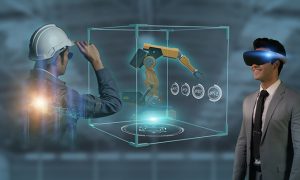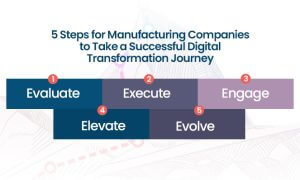Digital Transformation of Manufacturing Businesses
Are You Ready for Industry 4.0? The Digital Transformation of Manufacturing

According to many in the manufacturing industry, we are currently in the middle of the fourth industrial revolution, or industry 4.0. The digital transformation of manufacturing and their business processes has altered the manufacturing landscape, and any manufacturers who don’t adapt will get left behind. Here’s what you need to know about digital transformation in today’s manufacturing landscape.
What Kind of Technologies Are the Manufacturing Industry Using?

Tools to facilitate digital transformation vary widely. Depending on the size, complexity, existing digital technologies, and current digital infrastructure of your company, these solutions can range from a basic tool that facilitates interdepartmental communication to the most advanced data-driven software to improve customer experience.
Technologies Used in the Manufacturing Industry Today
Here are just some of the tools advanced manufacturing businesses and their chief information officers (CIOs) are using:
Artificial intelligence
Machine learning
Virtual reality
Augmented reality
Industrial Internet of Things, or industrial IoT
Software to create digital twins
Software to track inventory levels
Tools, such as industrial robots, to automate repetitive tasks
Additive manufacturing, or 3D printing
Advanced real-time data and analytics (for doing everything from illuminating issues with supply chains to meeting growing customer demands)
Why Are Traditional Manufacturing Companies and Industrial Manufacturers Turning to Digital Technology?

Embracing digital technologies offers many benefits, and now that so many senior executives are buying into the power of these new business models, manufacturing organizations are adopting these tools at an increasing rate.
Here’s what digital technologies can do for manufacturing processes, production processes, and the industry as a whole:
9 Ways Digital Transformation Opportunities Improve Your Manufacturing Business

Digital transformation in manufacturing is the future. The transition to “smart manufacturing” can provide so many concrete and quantifiable levels of value, including the following:
- Increase your global network
Digital tools can help you find, communicate with, and connect to a global pool of talent, resources, and potential customers. This gives you more reach and access than you would ever have without the aid of those tools.
- Anticipate and get out ahead of the future
Societal and market shifts provide significant hurdles for the manufacturing industry. Being innovative in mindset and open to the technologies that are going to facilitate that innovation can open doors that will stay shut for manufacturers who don’t embrace digital transformation.
- Maximize revenue and reduce costs
As in other industries, many manufacturers are implementing these changes because of the revenue impact.
The right suite of solutions can help manufacturing businesses increase profitability. It can create a more cost-effective way to approach a situation. It can stem costly rework. It can reduce the overall cost of production. (This is often seen with the 3D printing of consumer goods.)
All these things have real dollars-and-cents value to a manufacturing business.
- Improve decision-making capabilities

The leading manufacturers are those that gather, analyze, and use data. They have the tools to get the data in the first place. They have the capabilities to analyze that amount of data. Then they have the mindset to overlay data with their decision-making. When those three things come together, manufacturers are more likely to succeed.
- Increase operational efficiency
If you can use digital transformation strategies to create enhanced efficiency everywhere from your manufacturing business processes to your sales team, you will see change happen across your entire business.
Yes, you will see revenues rise and you’ll enjoy cost reduction, but you’ll also see more intangible and less quantifiable benefits, such as increased customer satisfaction and fewer issues with supply chains.
Something as simple as capitalizing on connected devices can help dramatically improve communication and even reduce travel costs.
- Improve energy efficiency of tools used
As more and more consumers become invested in the environmental impact of companies, manufacturing businesses can get out ahead by tracking the energy output of their tools.
Once the data is available, they can determine how to improve those numbers and, consequently, attract a larger segment of their customer base. This can also help with things like federal, state, or local mandates around energy use or other environmental restrictions.
- Deliver on customer expectations

Many things in manufacturing are outside your control. You can’t, for example, always dictate how supply chain is going to affect your product. You can, however, monitor supply chain with data and make data-driven decisions about how to proceed. If you see the problem coming early enough, you might even be able to think of creative ways to bypass the issue altogether. If not, you can at least be open and honest with your customers about the issue and what steps you’re taking to remedy it.
All these factors together can help improve overall customer experience. When you do that, you’re more likely to retain that customer, to successfully introduce upselling and cross-selling opportunities, and to see an overall higher lifetime value from that client.
- Increase worker safety
Some of the technologies used in the manufacturing landscape can actually increase worker safety. This includes adding sensors or increasing the number of sensors deployed throughout the manufacturing floor. These sensors can accomplish many things, including not allowing entrance to a restricted area if the proper safety gear is not detected on that worker.
- Surpass the Manufacturing Competition
Digital transformation is here. We’re already in the middle of industry 4.0. If your company isn’t taking measures to drive digital transformation, you run the risk of falling behind your competitors.
Success in the Manufacturing Industry Requires a Strategy-First Mindset
Just because other companies are implementing digital transformation in manufacturing plans does not mean you should panic. You can’t just start rolling out digital transformation initiatives at random.
Everything you do must be underpinned by a sound, reasoned digital strategy. Without a digital strategy that aligns to your overall digital business models, you have very little chance of seeing sustainable, scalable growth.
5 Steps for Manufacturing Companies to Take a Successful Digital Transformation Journey

Creating a smart factory that minimizes costs, increases revenue, overcomes supply chain issues, and outperforms the competition doesn’t happen without strategy. It takes planning, forethought, and time.
To select the digital technologies that actually move the needle for your company, follow this framework:
Evaluate
In this phase, you’re gathering as much information as possible. You’re determining who your relevant stakeholders are, and you’re talking directly to those stakeholders.
You’re determining what their pain points, challenges, hurdles, and barriers to success are.
You’re ascertaining goals and objectives.
Conduct Audits Beyond Stakeholders
Once you’ve thoroughly audited your stakeholders, it’s time to complete several other audits:
Your current technology
The entirety of your business processes
Existing strategy
Organizational capabilities
Note, capabilities is a key that many companies forget. If you don’t have the infrastructure to implement change, your transformation will never get off the ground.
You might, for example, want AI in your business, but if you don’t have the time or resources yet to gather that quantity and complexity of data, this solution isn’t a good fit.
Execute

This stage is all about strategy. Using the information from your “evaluate” stage, pinpoint the goals and objectives you’re seeking to achieve through technology. Then make sure everyone (every single relevant stakeholder) is aware of those goals. If you’re not all rowing in the same direction, you’re actively going in circles.
The overarching goal of strategy is to help your company stop being reactive in their decision-making. Don’t look at a problem in your supply chain and try to fix it with technology. Instead, look holistically at your company, and decide which one of your problems you want to solve in order to make the biggest overall impact. Start there. (Start there, even if it means leaving that nagging supply chain issue!)
People get very excited about the actual technologies that are going to be implemented in the organization. And this makes a lot of sense. The industrial Internet of Things and AI and a digital representation of a physical object are all exciting and transformative solutions.
But you can’t let that excitement allow you to skip the strategy stage. Otherwise you’ll just be throwing a lot of money at the industrial Internet of Things…with no results or ROI to show for it down the line.
Engage
In this stage, you’re looking to align the data and information you’ve gathered with solutions that will have a significant impact on your organization.
This is the time to actively research and to engage with potential solutions.
Evaluate any potential technology through several lenses
What problem it helps you solve.
What goal or objective it helps you achieve.
What pain point it resolves for your stakeholders.
The potential return on investment you’ll see.
The capabilities of your organization to effectively implement that solution.
Elevate

Once you’ve chosen your technology or technologies, it’s time to think strategically about adoption.
Because you involved your stakeholders from the very beginning, you’re already ahead of the adoption game. Your employees will be more invested in this process because they’ll feel their voices and input were heard.
The importance of adoption can’t be understated. If your stakeholders aren’t using the technology you implement to the greatest extent, you’re not seeing the best possible return on that investment.
3 Kinds of Less-Than-Optimal Technology Adoption
Unused technology: This is the most detrimental to ROI. This is when stakeholders simply don’t use the technology at all.
Sometimes it’s a matter of starting to use the technology and then dropping off over time. Other times, stakeholders never engage with the technology at all.
This can be an issue of incentivization, lack of knowledge or training, or issues created by the technology. (For example, it takes more time than it saves to use that tool.)
Misused technology: This is when a tool is used in a way it’s not intended. This almost always comes down to a coaching and training issue. Make sure you have a sufficient onboarding contingency to overcome this.
Underused technology: This is when stakeholders don’t capitalize on all the potential and relevant features of the tool. Again, more often than not, this is just a matter of implementing a better initial and ongoing training program.
Evolve
This final stage is all about scaling. If you’ve done the first four steps strategically, you should be in a place where you’re generating more income and overcoming hurdles to profits. (We’re looking at you, supply chain issues!)
When you’re in this position, you can confidently and responsibly start to grow and to evolve your business.
This framework is based on a strategic approach to selecting, adopting, and integrating sales technology into an organization. Learn more about the sales technology ecosystem now.
Want to Know More about the Digital Transformation of Manufacturing?

Still have questions? Want to learn more? Check out our webinar Important Steps Manufacturers Should Take When Creating a Digital Transformation Strategy for Your Sales Organization
Hear from a panel of industry experts as they explain what a digital transformation strategy looks like for manufacturers—and, more importantly, why it’s essential to successful manufacturing today.


